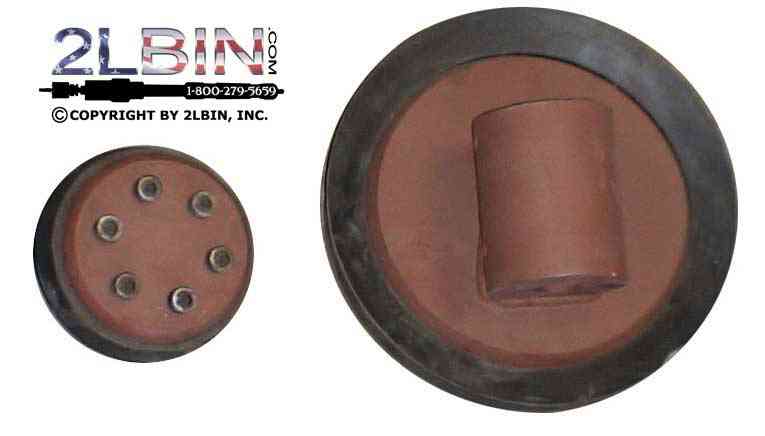The Pipestop 100 is a lightweight piece of equipment that is easily used for stopping low-pressure lines, 4" - 12", on most types of pipelines and fluids.
Maximum line pressure: 100 psi. Maximum Temperature: 350° F (121° C)
   
Pipestop100
100 psi.
|
Qty
|
Item #
|
Price
|
ANSI Flange Rating 150
|
4" PipeStopHead
|
1
|
PSH-0004-100
|
Call |
|
6" PipeStopHead
|
1
|
PSH-0006-100
|
Call |
|
8" PipeStopHead
|
1
|
PSH-0008-100
|
Call
|
|
10" PipeStopHead
|
1
|
PSH-0010-100
|
Call
|
|
12" PipeStopHead
|
1
|
PSH-0012-100
|
Call |
|
|
1
|
|
|
|
4"
Linestop Cup
|
1
|
BNLC-03875-0040
|
Call |
|
6"
Linestop Cup
|
1
|
BNLC-05875-0060
|
Call |
|
8"
Linestop Cup
|
1
|
BNLC-07875-0080
|
Call |
|
10"
Linestop Cup
|
1
|
BNLC-09875-0100
|
Call |
|
10"
Linestop Cup
|
1
|
BNLC-09875-0100
|
Call
|
|
4" - 8" LS Housing
|
1
|
PSH-04X3-100
|
Call
|
ANSI 150
|
10" -12" LSHousing
|
|
PSH-04X3-100
|
Call |
ANSI 150
|
|
|
|
|
|
4"
– 8" Pivot Ball assembly w/Plates
|
1
|
PSB-0150-100
|
Call |
1
½" I.D
|
10"–12"
Pivot Ball assembly w/Plates
|
1
|
PSB-0200-100
|
Call |
2"
I.D
|
4"
– 8" Stainless Short Bar
|
|
OSB-150-NB-100
|
Call
|
|
4"
– 8" Stainless
XL
Bar for Bypass
|
|
OSB-150-XL-100
|
Call
|
|
10"
– 12" Stainless
Short
Bar
|
|
OSB-200-NB-100
|
Call
|
|
10"
– 12" Stainless
XL
Bar for Bypass
|
|
OSB-200-XL-100
|
Call
|
|
|
|
|
|
|
4"
– 8" Crosstop
|
|
CTB-150-PS-100
|
Call
|
|
10"
– 12" Crosstop
|
|
CTB-200-PS-100
|
Call
|
|
|
|
|
|
|
4"
- 8" Cross Bar
|
|
COB-150-PS-100
|
Call
|
|
10"
– 12" Cross Bar
|
|
COB-150-PS-100
|
Call
|
|
Fig
F77-W4B Fabricated Knife Gate Valves - Fabricated Steel -304 stainless gate and
liner-Bi-directional resilient seat ½" over size bore
275
psi. cwp / 150Degree (F)
|
|
|
Call
|
|
4"
- 8" PS Valve
8
1/2" Port
|
1
|
FKG-0850-275
|
Call
|
275
psi cwp
|
10"
- 12" PS Valve
12
1/2" Port
|
1
|
FKG-1250-275
|
Call
|
275
psi cwp
|
|
|
|
|
|
8"
x 4" Valve Adapter
|
|
DMF-0408-275
|
Call
|
ANSI
150
|
8"
x 6" Valve Adapter
|
1
|
DMF-0608-275
|
Call
|
ANSI
150
|
10"
x 12" Valve Adapter
|
1
|
DMF-1012-275
|
Call
|
ANSI
150
|
|
|
|
|
|
4"
- 8" Completion Plug Holder
|
1
|
CPH-0408-275
|
Call
|
T-24 & H-30
|
10"-12"Completion
Plug Holder
|
|
CPH-1012-275
|
Call
|
T-24
& H-30
|
Optional Equipment
|
Qty.
|
Item#
|
Price
|
|
4"
PS Valve
4
½" Port
|
1
|
FKG-0450-275
|
Call |
275
psi
|
6"
PS Valve
6
½" Port
|
1
|
FKG-0650-275
|
Call |
275
psi
|
10"
PS Valve
10
½" Port
|
1
|
FKG-1050-275
|
Call |
275
psi
|
Completion
Plug Tool (thread-in)
10"
– 12" Adapter
|
1
|
CPT-0408-275
CPA-1012-275
|
Call |
150
psi
ANSI
150
|
4"
Tap/Linestop Adapter
|
1
|
PSA-0004-275
|
Call
|
275
psi.
ANSI
150
|
6"
Tap/Linestop
Adapter
|
1
|
PSA-0006-275
|
Call
|
275
psi.
ANSI
150
|
8"
Tap/Linestop Adapter
|
1
|
PSA-0008-275
|
Call |
275
psi.
ANSI
150
|
10"
Tap/Linestop Adapter
|
1
|
PSA-0010-275
|
Call |
275
psi.
ANSI
150
|
12"
Tap/Linestop Adapter
|
1
|
PSA-0010-275
|
Call |
275
psi.
ANSI
150
|
4" Housing
|
1
|
PSH-0004-100
|
Call |
ANSI 150
|
6" Housing
|
1
|
PSH-0006-100
|
Call |
ANSI 150
|
10" Housing
|
1
|
PSH-0010-100
|
Call |
ANSI 150
|
Bypass Housings
Require XL Actuator bars
|
|
|
Call |
|
4" Housing
w/3" Bypass Outlet
|
1
|
PSH-04X3-100
|
Call |
ANSI 150
|
6" Housing
w/ 4" bypass outlet
|
1
|
PSH-06X4-100
|
Call
|
ANSI 150
|
8" Housing
w/6" Bypass Outlet
|
1
|
PSH-08X6-100
|
Call
|
ANSI 150
|
10" Housing
w/ 8" bypass outlet
|
1
|
PSH-10X8-100
|
Call |
ANSI 150
|
12" Housing
w/10" bypass outlet
|
1
|
PSH-1210-100
|
Call
|
ANSI 150
|
Operation, using the Pipestop 100, can be repeated at a later date; many pipe and gas companies install line stop fittings instead of valves at points where a valving action will inevitably be required.
Types of line stops
Four types of line stops or pressure plugs get the job done:
Cylindrical plug
A cylindrical plug - made of elastomer or steel - is used to stop the line by sealing against machined surfaces.
Elastomer cup
An elastomer cup seals against the pipe bore. This popular seal is affected by line pressure and is available in the greatest range of pressures and sizes.
Expandable elastomer
An expandable elastomer stopper seals against the bore of the pipe. This type is for low-pressure applications only.
Inflatable gas bag
An inflatable gas bag or balloon seals against the bore of the pipe. This seal is generally independent of line pressure and must be restricted to very low pressures.
Technique
When line stopping, determining the best method is extremely important. There is no universal line stopping technique and the right technique depends on the following variables:
- temperature;
- pressure;
- size of main and wall thickness;
- interior condition of main deposits, corrosion, weld beads, etc.;
- duration of the line stop;
- degree of leakage tolerated; and,
- the flowing medium.
Complete, "bubble tight", shutoff is difficult to achieve. When it is achieved, it is usually the result of good job site techniques. On hazardous jobs, like steam or flammables, the use of special flanges can maintain a safe environment. (Pipe O.D. - (2 x Pipe Wall) = I.D.) This simple formula can be the most important factor in reaching a "bubble tight" shutoff. The pipe I.D. must be verified for every line stop.
Step-by-step
A special line stop fitting is installed on the pipeline either by welding or using a mechanical seal. After pressure testing, a temporary valve is installed onto the fitting.
First, a hole is made in the pipe with a special cutter. When the pressure tap is completed, the cutter and coupon are retracted into the tapping machine and the temporary valve is closed. If bypass taps are required, they are also made at this time.
The tapping machine is removed from the temporary valve and is replaced by a line stop machine. The valve is opened and the line stop plugging head is lowered in place, which cuts off flow in the pipeline.
To verify the effectiveness of the plugging head seal and to test the seal’s efficiency, a bleed-off point must be used. By opening the bleed-off and reducing the pressure on the downstream side of the head, or in the case of double line stops, in between stops, the pipeline pressure is used to help seal the plugging head.
When the work is completed and the line stop must be removed, line pressure is equalized on the "dead" side of the plugging head. This allows the head to be retracted and the line to be put back in service.
To complete the operation, the line stop machines are removed and completion machines are installed onto the temporary valves. A special closure plug is installed into the outlet flange of the line stop fitting, and the line stop machines and temporary valves are removed. Finally, a blind flange is usually installed to finish the line stop operation.
|
